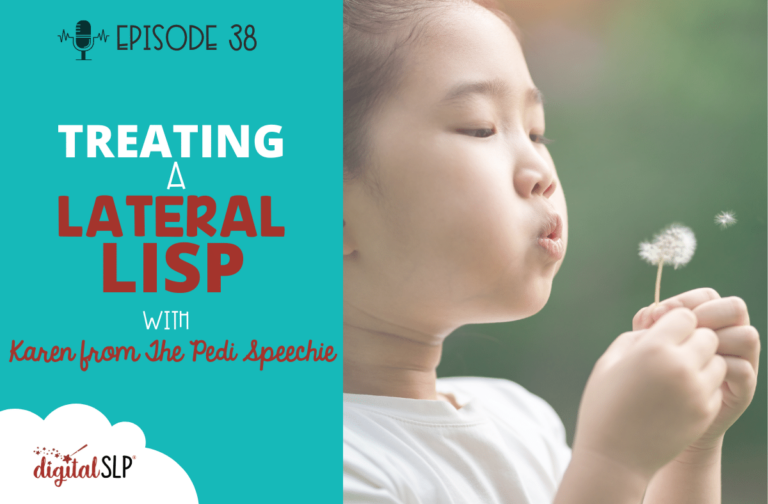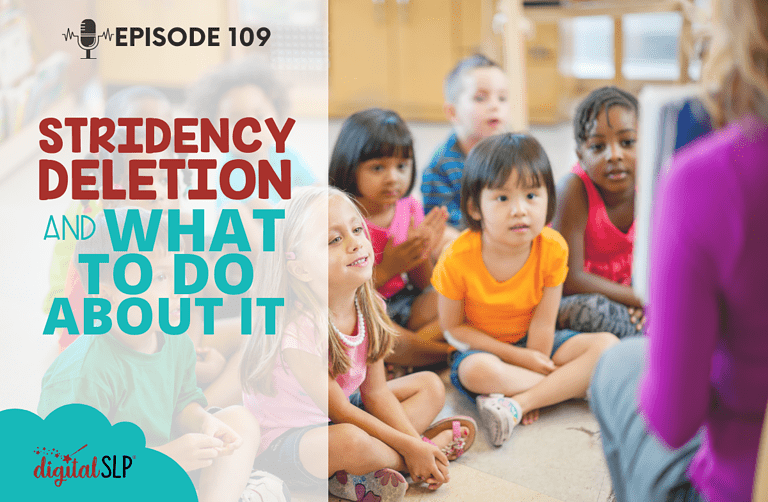Do you feel confident when treating a lateral lisp? If you need a confidence boost or actionable steps to get started, then this is definitely the episode for you! Tune into episode 38 to learn:
- actionable steps for treating a lateral lisp
- which steps must be mastered before moving on
- why using a “slow and steady” approach is key
- great resources for treating lateral lisps
Don’t forget to check out the links and resources section below to access resources that were mentioned in today’s episode.
Links and Resources:
- Orofacial myology training
- The Pedi Speechie Blog
- The Pedi Speechie TpT Store
- Lisp Speech Therapy Packet
- Lisp Video by Karen
- Tongue Tie 101
Full Transcript of Podcast: Treating a Lateral Lisp
Episode 38: Treating a Lateral Lisp
Jessica: You're listening to the Speech Space Podcast, a podcast full of tips and resources for SLPs. I'm your host, Jessica Cassity, and this is Episode 38. Hi, everyone! Thank you so much for joining me today to talk about working on a lateral lisp. Before we get started, I wanted to take a brief moment to let you know that this podcast is brought to you by The Digital SLP membership site, which is a site that features no print and low prep resources for SLPs. To learn more about The Digital SLP membership site, please head on over to thedigitalslp.com/digitalslp. So like I mentioned previously, we are going to be talking about treating a lateral lisp today. And my friend, Karen from the Pedi Speechie, is going to be jumping on here to talk about lisps. Before I bring her on, I did wanna give you all little background. Karen has been an SLP in both the school and outpatient settings. She treats the pediatric population and has taken extensive continuing education on orofacial myology and AAC. Her husband, John, is a dentist and she has a sweet toddler named Nathan and is dog mom to Moo. All right, let's jump right in and start talking about lisps with Karen. Hi, Karen! Welcome to the show.
Karen: Hey Jessica! Thanks for having me.
Jessica: Yeah, it's great to have you on. And I know our listeners are gonna be really excited to learn more about treating lisps. Before we get started, can you talk a little bit about what got you interested in the area of orofacial myology, and for those who are listening that don't know what that is. Can you explain a little bit about what that is?
Karen: Sure, yeah! Well, I actually was just getting pretty frustrated because I was having difficulty correcting lisps and vocalic /r/ errors. So I did a Google search on that and Sandra Holtzman's name came up. I don't know if you've heard of her.
Jessica: Yeah, I have.
Karen: You have. Okay. She's fantastic. She has a website, it's www.orofacialmyology.com, and she had this course and it kind of said in the description of it, that that is, you know, the foundational skills that you need for correcting lisp and /r/. So I emailed her, I got in touch with her, and we talked back and forth and then I decided to take the course and it's a pretty big deal. It's very serious time commitment. It's 28 continuing education hours.
Jessica: Oh, wow!
Karen: Yeah. So it was like a four-day thing. It was no, no joke. So...
Jessica: Yeah. So is that self-paced or...?
Karen: No, it was, she gave, I can't remember... Maybe there was 12 of us and, and it was just like, so it was a very small course and it was at a hotel, she was there also with a dental hygienist and they gave the course together. They presented together and in the course was actually a mixture of SLPs and dental hygienist too.
Jessica: Oh, very cool. Very cool. Yeah, it's funny. I actually know of her because my second daughter had some difficulty with breastfeeding and I found out that she had a posterior tongue tie. So I was like this crazy mom with this newborn, like in the middle of the night, like Googling like tongue tie. And of course her name came up and I was like, I took one of her courses on, I think it's like tongue tie 101 or something like that.
Karen: Yeah.
Jessica: Yeah. She definitely knows her stuff for sure.
Karen: Yeah. But basically what we did is, she gave a very thorough course on, you know, the structure, the normal structure, how your muscles... facial muscles work together. It was more of like... gosh, I'm trying to think of how they described it. So dentistry is maybe more of like the teeth-together relationship, whereas orofacial myology, it's kind of more of the teeth-apart relationship, how things are working together. The strength and coordination of the orofacial musculature, if that makes sense.
Jessica: Yeah. Yeah. That definitely makes sense.
Karen: I'm probably not doing a great job explaining that, but...
Jessica: That makes perfect sense to me. Now, what are some of the adverse oral negative habits that an SLP should be on the lookout for whenever they are working with students with a lisp?
Karen: Definitely things like thumb sucking or sucking on clothing. I also wanna point out that you should really keep an eye out for what type of sippy cups kids are using. Even for older kids, I've had some kids come in when I was an outpatient, I had some kids come in that were older than I thought would still be using sippy cups. And the ones with the hard spouts is what I wanna specify. The ones that what they do is they push the tongue out of the natural resting position and they can also affect dentition too. So that's why if you go to the store and you see those sippy cups that have like the dentist-approved, you know, 360-degree rim. Do you know what I'm talking about? Those are the ones you want. So you don't want ones that have like a real hard spout that comes up because those just push everything out of place. So, that's another thing to look out for. And one more thing to --this isn't a negative habit -- so I'm kind of, I'm kind of going off on my own, but I also wanted to point out before I forget to. One other thing to look for would be enlarged tonsils as well.
Jessica: Okay. All right. Great. Great. Now, when you're treating a lateral lisp, do you have a specific process that you use or where do you generally like to begin?
Karen: Yeah, actually I have a very, very structured approach. So after I took the course, I talked with Sandra for a little bit and, and we were discussing, you know, correcting a lisp and we were going over things and she shared with me her very, very structured approach. So I started using that approach as well. And I can summarize it in a nutshell.
Jessica: Okay. Yeah. Yeah, that'd be great.
Karen: It's basically, what I do when I'm working with my kids is I start by teaching them the correct lingual resting posture. So they learn that their tongue tip should be resting at the alveolar ridge. We call that "finding the spot" or "finding home." A lot of these students put their tongue tip. They're like push them against their teeth. So their tongue isn't resting where it should be. So I focus first on finding that position and maintaining that position even at rest. Like even when they're not speaking. So we go over, you know, "Hey, if you're just sitting in class, what's your tongue doing?" Like we talk about, you know, the correct, you know, how your lips are closed. Your teeth are slightly apart, your tongue tips on the alveolar ridge and you are breathing through your nose. So we actually go over that first and I usually send home homework about keeping the tongue tip on the alveolar ridge. I'll send like a little, you know, just random checks. We'll pick a time that they might check and they can just tell me if yes or no, if their tongue was on the spot just to kind of learn awareness. So that's where I start.
Jessica: Yeah, that's great.
Karen: So after that, because I know that's, you know, that's not something you can maybe really do in therapy a whole lot, but that's just something I bring to their attention. And then we talk about it over and over again for a couple sessions until I know that they've got it. Well, Sandra has phase one orofacial myology exercises. And so there's a couple that I really do, but what those basically work on are repeated controlled movements of the tongue tip to the alveolar ridge and not just the alveolar ridge, I'm just focusing on the lisp aspect of it here. So we work on those and then after we have established that, we work on what's called a whispered /t/ and it's super, super important that my students, by this point, understand that correct lingual resting posture because we're now using it to establish a whispered /t/. So it's just like, it sounds like it's just a really gentle /t/, /t/, small amount of air flow. So you're just literally having them whisper a /t/. But you're making sure that the tongue tip is resting on the alveolar ridge and then once they have that down, which I'm literally making this sound like it's super fast, it isn't. I have spent, you know, usually at this point I'm up to two months in therapy. So slow and steady is the way to do this. It really is learning new habits. So I don't think that you can rush this. I just, at least I can't when I'm working with students, but after they get the whispered /t/, the next thing that I have them do is the long /t/ and that's slowly adding airflow to the whispered /t/. So it's more of a /ts/ I don't know if you can hear that very well. And I just wanna point out too, when my students with like interdental lisps do the long /t/, they get it fairly quickly because they don't have, once they've gotten that lingual resting posture and they understand the tongue tip to the alveolar ridge, they don't have to like fight with that like lateralized airflow. But my kids that have lateral lisps and they still have like the, you know, they still have to then learn how to control the airflow as well. So for my kids with lateral lisps, that long /t/ that can take a while. I mean, and I sometimes have to even change how I'm modeling it to, you know what I mean? Like we have to start really, really slow. So I just kind of wanna throw that in there with, with the long /t/. Some of your kids are not gonna be ready to just jump right into they'll be like /shh/, you know, so then you kind of have to slow them down and just step-by-step, slowly get them there.
Jessica: Yeah, now, I think that's a really important reminder because I think it can be easy to get discouraged or feel like what you're doing isn't working when in reality like you said, slow and steady might just be the key.
Karen: Absolutely. Like, and I don't, I mean, I've had students - really hard workers, older students where this has taken, you know, this whole process up to this point that I've talked to has taken six months, you know? So it's not always just this quick, quick thing. And I think maybe people get frustrated if they think that this type of thing can be learned in like a few sessions. In my experience, at least it, it just takes time. But after they've got that long /t/, then what you wanna do is move into the final /ats/ words. So words like "hats," "bats," "cats," words like that. Don't use any words with like competing /s/ or /z/ sounds because that'll throw them off and then I spend some time there and then I use coarticulation to get to this /s/ sound in isolation from that. So I might pair "cats" and then I'll pair like, I meant to say words, sorry, not isolation. So I might, my coarticulation phrase or sentence might be something like "cats say hi." So we use that /ats/, which we learned. You know, we used that long /t/, which we put on to final /ts/ words and now we're kind of using that to bridge the gap, to get to this /s/ initial words. So I used a lot of coarticulation. So "cats say hi." You know, it doesn't have to be anything crazy. You can even practice the same, the same thing over and over again if you want. But yeah, just, just keep practicing on those and just again, make sure that there's no other /s/ or /z/ words when you're practicing. Because you don't wanna, you wanna be encouraging and that will be defeating. You know, if there's other words when they're trying so, so hard to get those ones on there. So that's where I go. And then once they get that, then you can kind of go into like the more traditional articulation approach, at least that's how I do it, so...
Jessica: Can you talk a little bit about the rationale for why you choose those final, the /ts/ and use coarticulation?
Karen: Yeah. for me I've spent so much time with my students establishing the tongue tip, being on the alveolar ridge and with the final /ts/ words, they've already got it right where I wanted it to be. And so, you might have to, when you're first starting like put a big pause in between, so let's say, we're saying the word "bats," most of your kids, when you're first starting this, they're gonna slip back into like, you know, back they're gonna slip right into that. They're gonna forget their long /t/ that you've just worked on so hard. So what I do is I model a big pause in between there. So it's /ba/, /ts/, and then we really, really slowly focused and controlled get that final /ts/ sound. So just say, "Hey look, you guys, you already know how to do this. We're just adding a little bit of sound, you know, before." So that's my rationale. It's just kind of like a very structured one thing follows the next type of approach.
Jessica: Right.
Karen: So hopefully that makes sense.
Jessica: Yeah, yeah, no, that definitely makes sense. I just wanted to, to be clear if anyone was listening and wondering why you start with those words and use the coarticulation. So once you do that and then where do you go from there? You said that you start moving into traditional arctic approach?
Karen: Yeah, once they've got that down, I really just, we start with our, you know, initial /ts/ words and I just kinda go from there. Honestly. I'm trying to think of if I had like a, oh, I'm like still on my we're starting back like in a few weeks there and like in that mindset, you know, like getting back into it. But yeah, no, I, I just kind of go from there and get right back into the, you know, we do it in all positions. I move in into phrases and just kind of go like that.
Jessica: Yeah. And then I feel like it's smooth sailing. I mean, I feel like once they get those final /ts/ words, I feel like the rate of progress, like skyrockets.
Karen: Yes, absolutely. I was, oh yeah, you were just asking me then I thought of something else. I was gonna say like you could try if you wanted to get more practice with the final /ts/ you can use those type of coarticulation things, you know, in longer sentences or shorter passages or paragraphs if you want to. But it can be hard to make sure there's no other /s/ or /z/ in there, so...
Jessica: Right. Yeah. It can be a little extra work there. So is there anything that you feel like we missed or that you wanna touch on that you think SLPs listening might need to know or want to know about treating lisps?
Karen: I'm trying to, I'm trying to think...
Jessica: I feel like we covered a lot. I mean, you went through a nice kind of step-by-step program there.
Karen: I think that one thing to remember is that like, at least for my students, they will get it in this controlled environment and then it like goes away, so like in conversation. So I have my student who was like, I mean, we'd corrected the lateral lisp and he could do read aloud tasks. He could do all this stuff. And I'm like, "oh my gosh, this is so amazing." And then the next thing I know, he starts talking about his Xbox and, everything fell apart. So just taking the time to do some of those conversational things and, you know, and I also like to check in with teachers too. And you really have to, you know kind of explain maybe what you're looking for, but just kind of maybe check in. If you have teachers that are willing to kind of listen for it. I know that can be with 30 kids in the class, that can be a little bit challenging, but if, you know, if there's a possibility for that, I usually just explain what we're working on. So if they happen to catch it, it's just one more person to listen for it. Yeah.
Jessica: Yeah. Well, that's a great piece of advice there. Now. I know that you have a really amazing resource for treating lisps on Teachers Pay Teachers. Can you talk a little bit about that?
Karen: Oh, sure. Thank you. That, basically, is a resource that follows the exact same structured approach that I was talking about. So I had talked with Sandra and I learned so much from her and I went back from this course full of this amazing knowledge. And I really sat down and like I was trying to figure out, you know, all these finals /ts/ words and phrases and coarticulation sentences and all this stuff. And you know, I was trying to gather all the things I needed to do this. So I decided I would just create something. And for a while I only used it myself and I just, I didn't know, you know. I contacted Sandra finally, and I was like, I don't know if you're okay with me putting this out there because you know, it's based off of your course. And I'll just send it to you, again I'm not offended if you don't want me to put it up on Teachers Pay Teachers and she looked it over and she said, can you make an /r/ one too?
Jessica: Oh, that's awesome!
Karen: So I was pretty excited about that. Yeah.
Jessica: Yeah, that's really exciting. So if our listeners are wanting to find this, what's it called? How do we find it?
Karen: Yeah. if you just go to my store on Teachers Pay Teachers and I mean it's pretty, I think it's just like Lisp Speech Therapy, nothing crazy. If you just type that in, in my store you will find it. But I also have some custom categories in my store. Like there's, it would be under the articulation custom category and there's an actual treating a lisp custom category in my store so they can find it there. And also I have a video recording. I did a video on Facebook after a few people asked me. I did a Facebook live on correcting a lisp as well. And I put that video, yeah, it's on Teachers Pay Teachers as well, too. So if anyone wanted to refer back to it, they could also look at that or listen to that.
Jessica: All right, great. I'll make sure that I link to your store in the show notes as well as to that specific product that you were describing and the video too.
Karen: Awesome.
Jessica: All right, you're welcome. All right, Karen, it's been a pleasure to have you on this show and thank you so much for sharing your words of wisdom about lisps today.
Karen: Thank you for asking me to come on. I'm excited.
Jessica: I hope that you enjoyed listening to today's episode and that you found that these tips were helpful. Don't forget to check the show notes for all the links that we mentioned as well. And as always, if you like what you heard, please take a second to give a five-star review on iTunes to help your fellow SLPs find the show. Are you guys on Instagram? Instagram is a great way to stay connected and get updates about new episodes. Follow along @thedigitalslp and feel free to DM me anytime. That's it for me for today. I thank you guys for tuning in and I hope that you have a wonderful week.













Recent Comments